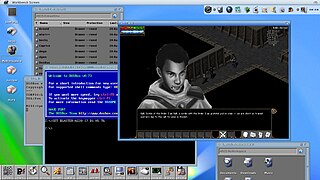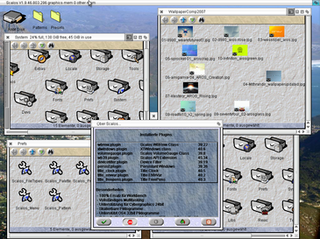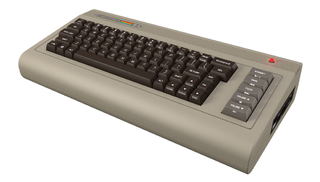
Amiga is a family of personal computers introduced by Commodore in 1985. The original model is one of a number of mid-1980s computers with 16- or 16/32-bit processors, 256 KB or more of RAM, mouse-based GUIs, and significantly improved graphics and audio compared to previous 8-bit systems. These systems include the Atari ST—released earlier the same year—as well as the Macintosh and Acorn Archimedes. Based on the Motorola 68000 microprocessor, the Amiga differs from its contemporaries through the inclusion of custom hardware to accelerate graphics and sound, including sprites and a blitter, and a pre-emptive multitasking operating system called AmigaOS.

The Amiga 1000, also known as the A1000, is the first personal computer released by Commodore International in the Amiga line. It combines the 16/32-bit Motorola 68000 CPU which was powerful by 1985 standards with one of the most advanced graphics and sound systems in its class. It runs a preemptive multitasking operating system that fits into 256 KB of read-only memory and was shipped with 256 KB of RAM. The primary memory can be expanded internally with a manufacturer-supplied 256 KB module for a total of 512 KB of RAM. Using the external slot the primary memory can be expanded up to 8.5 MB.

Commodore International Corporation was a Bahamian home computer and electronics manufacturer with executive offices in the United States founded by Jack Tramiel and Irving Gould. Commodore International (CI), along with its subsidiary Commodore Business Machines (CBM), was a significant participant in the development of the home computer industry in the 1970s to early 1990s. In 1982, the company developed and marketed the world's second-best selling computer, the Commodore 64, and released its Amiga computer line in July 1985. Commodore was one of the world's largest personal computer manufacturers, with sales peaking in the last quarter of 1983 at $49 million.

The history of the graphical user interface, understood as the use of graphic icons and a pointing device to control a computer, covers a five-decade span of incremental refinements, built on some constant core principles. Several vendors have created their own windowing systems based on independent code, but with basic elements in common that define the WIMP "window, icon, menu and pointing device" paradigm.
MorphOS is an AmigaOS-like computer operating system (OS). It is a mixed proprietary and open source OS produced for the Pegasos PowerPC (PPC) processor based computer, PowerUP accelerator equipped Amiga computers, and a series of Freescale development boards that use the Genesi firmware, including the Efika and mobileGT. Since MorphOS 2.4, Apple's Mac mini G4 is supported as well, and with the release of MorphOS 2.5 and MorphOS 2.6 the eMac and Power Mac G4 models are respectively supported. The release of MorphOS 3.2 added limited support for Power Mac G5. The core, based on the Quark microkernel, is proprietary, although several libraries and other parts are open source, such as the Ambient desktop.
Amiga, Inc. is a company that used to hold some trademarks and other assets associated with the Amiga personal computer.
The Amiga is a family of home computers that were designed and sold by the Amiga Corporation from 1985 to 1994.
AmigaOS is the proprietary native operating system of the Amiga personal computer. Since its introduction with the launch of the Amiga 1000 in 1985, there have been four major versions and several minor revisions of the operating system.

Minimig is an open source re-implementation of an Amiga 500 using a field-programmable gate array (FPGA).

Workbench is the desktop environment and graphical file manager of AmigaOS developed by Commodore International for their Amiga line of computers. Workbench provides the user with a graphical interface to work with file systems and launch applications. It uses a workbench metaphor for representing file system organisation.
Intuition is the native windowing system and user interface (UI) engine of AmigaOS. It was developed almost entirely by RJ Mical. Intuition should not be confused with Workbench, the AmigaOS desktop environment and spatial file manager, which relies on Intuition for handling windows and input events. Workbench uses Intuition to produce displays and AmigaDOS to interact with filing system: AmigaDOS is built on Exec.

AmigaOS 4 is a line of Amiga operating systems which runs on PowerPC microprocessors. It is mainly based on AmigaOS 3.1 source code developed by Commodore, and partially on version 3.9 developed by Haage & Partner. "The Final Update" was released on 24 December 2006 after five years of development by the Belgian company Hyperion Entertainment under license from Amiga, Inc. for AmigaOne registered users.
Zune is an object-oriented GUI toolkit which is part of the AROS project and nearly a clone, at both an API and look-and-feel level, of Magic User Interface (MUI), a well-known Amiga shareware product by Stefan Stuntz.

AROS Research Operating System is a free and open-source multi media centric implementation of the AmigaOS 3.1 application programming interface (API) which is designed to be portable and flexible. As of 2021, ports are available for personal computers (PCs) based on x86 and PowerPC, in native and hosted flavors, with other architectures in development. In a show of full circle development, AROS has been ported to the Motorola 68000 series (m68k) based Amiga 1200, and there is also an ARM port for the Raspberry Pi series.

AmigaOS is a family of proprietary native operating systems of the Amiga and AmigaOne personal computers. It was developed first by Commodore International and introduced with the launch of the first Amiga, the Amiga 1000, in 1985. Early versions of AmigaOS required the Motorola 68000 series of 16-bit and 32-bit microprocessors. Later versions were developed by Haage & Partner and then Hyperion Entertainment. A PowerPC microprocessor is required for the most recent release, AmigaOS 4.

The Amiga 1200, or A1200, is a personal computer in the Amiga computer family released by Commodore International, aimed at the home computer market. It was launched on October 21, 1992, at a base price of £399 in the United Kingdom and $599 in the United States.

Scalos is a desktop replacement for the original Amiga Workbench GUI, based on a subset of APIs and its own front-end window manager of the same name. Scalos is NOT an AmigaOS replacement, although its name suggests otherwise. Its goal is to emulate the real Workbench behaviour, plus integrating additional functionality and an enhanced look. As stated on its website, the name "Scalos" was inspired by the fictional time-accelerated planet Scalos in the Star Trek episode "Wink of an Eye".

The Commodore 64x is a replica PC based on the original Commodore 64, powered by x86 Intel processors ranging from the Intel Atom to the Intel Core i7. It was sold by Commodore USA starting in April 2011. Because Commodore USA went out of business after the death of its founder, Barry Altman, this machine as originally intended to be configured with Extreme and Ultimate models was not readily available with Commodore branding for a period of several years until it was publicly relaunched in June 2022. The Kickstarter was hit with a cease and desist letter from Italian Commodore Engineering who have since apologized with the result being the crowdfunding campaign going back online and achieving Kickstarter's Project We Love status.

Commodore OS is a community driven free-to-download Linux distribution for Commodore enthusiasts purchasing Commodore licensed computer equipment. First developed by Commodore USA, it was intended for use on their range of PCs, particularly the Commodore 64x and Vic Slim computers. The first public beta version was released on 11 November 2011. It was based on Linux Mint, and used the GNOME 2 desktop environment. The company became defunct in 2013 before version 1.0 of the OS could officially come out of beta.
Barry S. Altman was the founder and CEO of Commodore USA from 2010 until his death in late 2012. Prior to founding Commodore USA, Barry worked for over 20 years in the satellite and communications industry. During his time at Commodore USA, the Commodore 64x was announced and put up for pre-sales. On December 8, 2012, Barry died from a prolonged battle with cancer.














